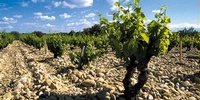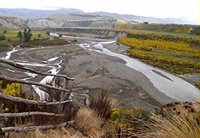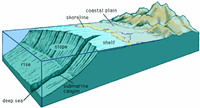|
|
 |

The rudiments of geology inform us that there are three types of rocks -- igneous, sedimentary and metamorphic. The rock cycle begins with igneous rock. These are crystalline rocks, formed at high temperatures below the crust of the earth and extruded, variously, as basalt flows or volcanic eruptions. Once these primary rocks reach the surface of the earth, they begin to erode. The crystalline structure of the rock degrades under surface conditions and the once well-integrated crystalline matrix disintegrates into particles of various sizes -- from tiny clay particles to silt, sand and gravel sizes. These accumulate and, as they are buried more deeply, become compressed and lithified into sedimentary rocks. Metamorphic rocks are a category in between. When sedimentary rocks are subjected to ever-greater heat and pressure, they begin to change and develop crystalline structures. If they are heated further, they will ultimately re-melt entirely and become igneous rocks again.
As students of wine, we often find our investigations involving the geology of a specific winegrowing region. We talk about various soil types and bedrock origins with great enthusiasm, although the exact connection between the earth and the vine remains something of a mystery. When geologists look at the surface of the earth, we ask how it came to be. The surface and subsurface features we see in sedimentary rocks and soils are consequences of their respective depositional environments. We study the processes that create the bedrock and surface soils that we observe.
Any area where sediment is capable of accumulating is considered a depositional environment. Each depositional environment possesses distinctive physical, chemical, and biological characteristics. They can be categorized as continental, transitional, and marine settings of various ages. Some environments are of recent development and their formative forces are relatively clear. Others are based on rocks formed millions of years ago. The study of these paleoenvironments requires a great deal of interpretation and many assumptions must be made on limited evidence.
Continental environments are those that occur on land; these include rivers and streams, lakes, deserts and areas affected by glaciers. The factors that allow deposition behave differently in each environment.
Rivers and streams, also known as fluvial environments, are dominated by flowing water. They can be categorized as either a meandering stream system or a braided stream system. Braided stream systems are typically found in areas with steep gradients with fast-moving water that forms multiple shallow channels. In these areas, the water contains a high sediment load. Examples of braided stream deposits in the wine world can be found most prominently in Bordeaux. The gravel mounds of the Haut-Médoc were deposited by high-energy rivers, swollen by glacial meltwaters and carrying heavy sediment loads. Because braided stream systems are high energy, smaller sized sediments, such as silts and clays, are not deposited but rather washed further downstream. We can observe this phenomenon in the Médoc, with the percentage of clay in the soil rising as we move downstream from Pauillac to St. Estephe and northward toward the ocean.

The Galets of Châteauneuf-du-Pape
The vineyards of Châteauneuf-du-Pape are famous for the large, rounded stones, or galets. These are indicative of a high-energy depositional environment as well. As the African tectonic plate collided with the European plate, the Alps were pushed up. As mountains are built and elevation increases, there is great potential energy that is released as kinetic energy in the form of rivers that bring down large amounts of sediment from the newly-formed peaks. When enhanced by vast volumes of glacial meltwaters, there is a manifold increase in the carrying capacity of the Rhône River and its tributaries. The result is the galets that form the surface of many Châteauneuf vineyards.
We find other braided stream deposits in New Zealand. The Gimblett Gravels of Hawkes Bay are braided stream deposits. The Wairau and Awatere River Valleys that course through the Marlborough appellation offer another example.

Braided Channels in the Awatere River Valley
Marine environments include the continental shelf, continental slope, and the deep sea floor. Material eroded from the continents is eventually deposited within the marine environments along with other materials that precipitate directly from the seawater. The characteristics of sediments deposited in a marine environment are determined by the environment's distance from shore, turbulence, biological activity, and depth of water.
The continental shelf is the gently sloping area that adjoins the continental mass. It combines both a high energy and a low energy environment. The high-energy area is located closest to the shoreline -- the beach. Here wave action and tidal currents are constantly moving and churning the sediments. Further from shore, in the lower energy outer shelf environment finer sediments, such as silts and clays, are deposited.

The Continental Shelf and Slope
As sediment moves across the continental shelf it eventually comes to rest at the continental slope. Here, the sediment is often transported down the continental slope in what geologists call turbidity currents. These are sediment-laden waters that flow with gravity down the continental slope and eventually spread out over the deeper sea floor. The sandstones and shales of California’s Franciscan Formation are an example of continental slope and deeper water depositional environments. They form the base of the soil for many Cabernet vineyards on the west side of Napa Valley.
Beyond the continental shelf the sea floor is covered by clay particles. This is a quiet water, low-energy environment where fine-grained sediments build up slowly. Within the clay sediments are tiny remnants of microscopic organisms that contain calcium carbonate. These become the base for many fine-grained limestone deposits around the world.
|
 |
|